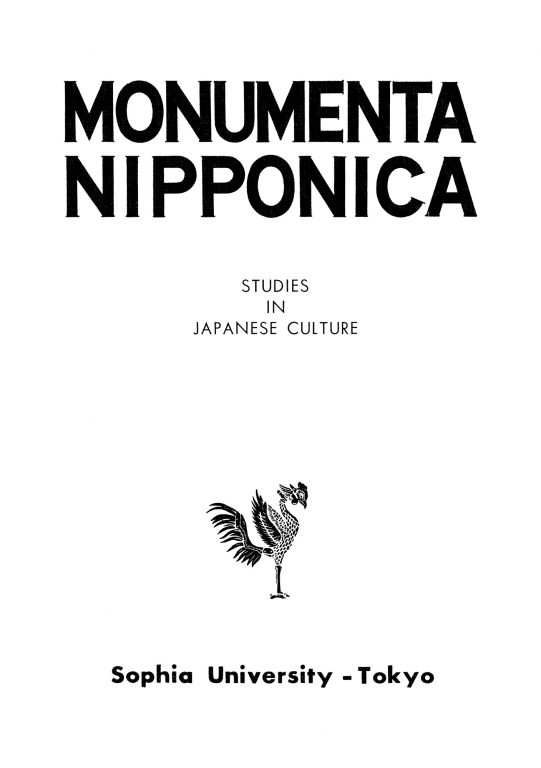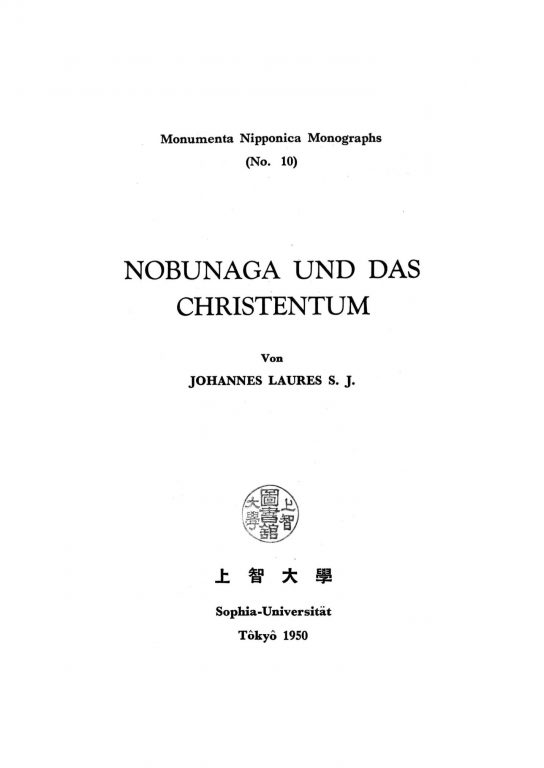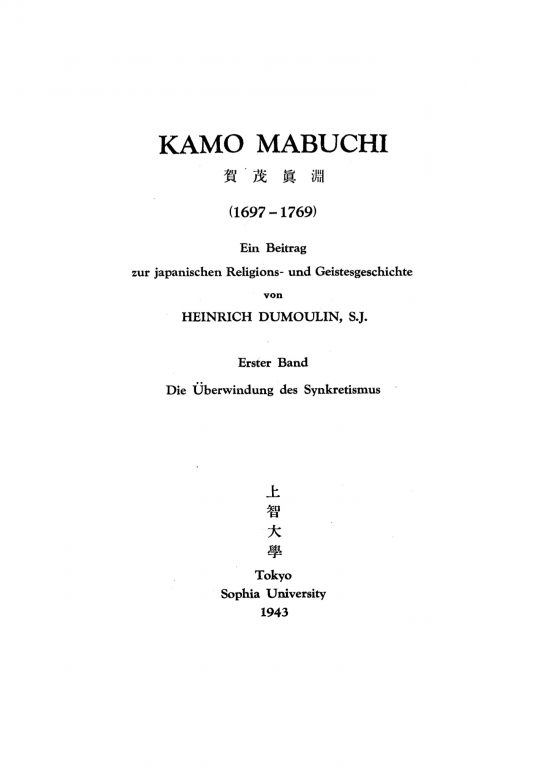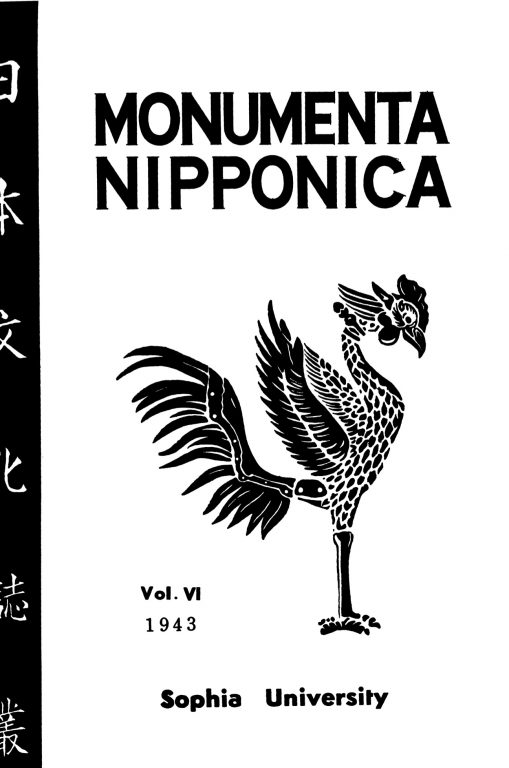Founded in 1938 and published semiannually by Sophia University MN 7:1/2 (1951) 269–99Second Supplement to Kirishitan BunkoJohannes Laures
MN 7:1/2 (1951) 269–99Second Supplement to Kirishitan BunkoJohannes Laures MN 7:1/2 (1951) 300–10The Lore of the Chinese Lute (Monumenta Nipponica Monographs, Tōkyō 1940) Addenda and Corrigenda (Part 6)Robert Hans van Gulik
MN 7:1/2 (1951) 300–10The Lore of the Chinese Lute (Monumenta Nipponica Monographs, Tōkyō 1940) Addenda and Corrigenda (Part 6)Robert Hans van Gulik MN 7:1/2 (1951) 311–18Buddhism and HaikuReginald H. Blyth
MN 7:1/2 (1951) 311–18Buddhism and HaikuReginald H. Blyth MN 7:1/2 (1951) 319–26New Japanese-English Kanji-DictionaryHans Müller
MN 7:1/2 (1951) 319–26New Japanese-English Kanji-DictionaryHans Müller MN 7:1/2 (1951) 327–38Sakoku-Nippon no Higeki (Die Landesabschliessung-Japans Tragödie) by Tetsurō WatsujiHubert Cieslik
MN 7:1/2 (1951) 327–38Sakoku-Nippon no Higeki (Die Landesabschliessung-Japans Tragödie) by Tetsurō WatsujiHubert Cieslik MN 7:1/2 (1951) 338–39The Meeting of East and West by F. S. C. NorthropWilhelm Schiffer
MN 7:1/2 (1951) 338–39The Meeting of East and West by F. S. C. NorthropWilhelm Schiffer MN 7:1/2 (1951) 339–41Nihon Kodai-Shi no Sho-Mondai (Untersuchungen über die japanische Frühgeschichte) by Mitsusada InoueHubert Cieslik
MN 7:1/2 (1951) 339–41Nihon Kodai-Shi no Sho-Mondai (Untersuchungen über die japanische Frühgeschichte) by Mitsusada InoueHubert Cieslik MN 7:1/2 (1951) 341–44Chūsonji to Fujiwara-Yodai. (Der Chūsonji und die vier Fujiwara)Hubert Cieslik
MN 7:1/2 (1951) 341–44Chūsonji to Fujiwara-Yodai. (Der Chūsonji und die vier Fujiwara)Hubert Cieslik MN 7:1/2 (1951) 344–46Age de Kamakura, Sources (1150–1333). Archives, Chartes Japonaises (Monjo) by F. Joüon des LongraisPierre Humbertclaude
MN 7:1/2 (1951) 344–46Age de Kamakura, Sources (1150–1333). Archives, Chartes Japonaises (Monjo) by F. Joüon des LongraisPierre Humbertclaude MN 7:1/2 (1951) 346–49Epistolae S. Francisci Xaverii Aliaque Eius Scripta by Ediderunt Georgius Schurhammer, Iosephus WickiJohannes Laures
MN 7:1/2 (1951) 346–49Epistolae S. Francisci Xaverii Aliaque Eius Scripta by Ediderunt Georgius Schurhammer, Iosephus WickiJohannes Laures MN 7:1/2 (1951) 349–53Il Ceremoniale per I Missionari del Giappone by Alexandro Valignano, Guiseppe Fr. SchütteJohannes Laures
MN 7:1/2 (1951) 349–53Il Ceremoniale per I Missionari del Giappone by Alexandro Valignano, Guiseppe Fr. SchütteJohannes Laures MN 7:1/2 (1951) 353–56Alessandro Valignano S.I., Historia del Principio y Progresso de la Compañia de Jesús en las Indias Orientales (1542–64) by Josef WickiJohannes Laures
MN 7:1/2 (1951) 353–56Alessandro Valignano S.I., Historia del Principio y Progresso de la Compañia de Jesús en las Indias Orientales (1542–64) by Josef WickiJohannes Laures MN 7:1/2 (1951) 356–59Storia dell’ Introduzione del Cristianesimo in Cina, Scritta da Matteo Ricci S. I. by Pasquale M. D’EliaJohannes Laures
MN 7:1/2 (1951) 356–59Storia dell’ Introduzione del Cristianesimo in Cina, Scritta da Matteo Ricci S. I. by Pasquale M. D’EliaJohannes Laures MN 7:1/2 (1951) 359–60Asiens Kritik am Abendländischen Christentum by Thomas OhmHermann Heuvers
MN 7:1/2 (1951) 359–60Asiens Kritik am Abendländischen Christentum by Thomas OhmHermann Heuvers MN 7:1/2 (1951) 360–631. Kōshitsu to Kirishitan Fukyō (La Famille Impériale et la Propagation de la Foi Chrétienne) by R.P. Laures; 1 bis. Das Japanische Kaiserhaus und die Alte Katholische Mission. Dans “Neue Zeitschrift für Missionswissenschaft,” 1949 by R.P. Laures; 2. Kirishitan-Shi Nyūmon (Introduction à l’Histoire Kirishitan) by R.P. Laures; 3. Oda Nobunaga to Kirisuto-Kyō. (Oda Nobunaga et le Christianisme) by R.P. Laures; 3 bis. Oda Nobunaga und das Christentum by R.P. Laures; 4. Kinki Shoki Kirisuto-Kyō-Shi (Débuts du Christianisme autuor de Kyōto) by R.P. Laures; 5. Takayama Ukon no Shōgai. (Vie de Takayama Ukon). Vol. I. by R.P. Laures; 6. Sei Francisco Xavier no Shōgai (Vie de St. François Xavier) by R.P. LauresPierre Humbertclaude
MN 7:1/2 (1951) 360–631. Kōshitsu to Kirishitan Fukyō (La Famille Impériale et la Propagation de la Foi Chrétienne) by R.P. Laures; 1 bis. Das Japanische Kaiserhaus und die Alte Katholische Mission. Dans “Neue Zeitschrift für Missionswissenschaft,” 1949 by R.P. Laures; 2. Kirishitan-Shi Nyūmon (Introduction à l’Histoire Kirishitan) by R.P. Laures; 3. Oda Nobunaga to Kirisuto-Kyō. (Oda Nobunaga et le Christianisme) by R.P. Laures; 3 bis. Oda Nobunaga und das Christentum by R.P. Laures; 4. Kinki Shoki Kirisuto-Kyō-Shi (Débuts du Christianisme autuor de Kyōto) by R.P. Laures; 5. Takayama Ukon no Shōgai. (Vie de Takayama Ukon). Vol. I. by R.P. Laures; 6. Sei Francisco Xavier no Shōgai (Vie de St. François Xavier) by R.P. LauresPierre Humbertclaude MN 7:1/2 (1951) 363–65Itō Jinsai, A Philosopher, Educator and Sinologist of the Tokugawa Period by Joseph John SpaeWilhelm Schiffer
MN 7:1/2 (1951) 363–65Itō Jinsai, A Philosopher, Educator and Sinologist of the Tokugawa Period by Joseph John SpaeWilhelm Schiffer MN 7:1/2 (1951) 365Chugoku Kodai Seiji Shisō (Political Ideals in Ancient China) by Nakae UshikichiWilhelm Schiffer
MN 7:1/2 (1951) 365Chugoku Kodai Seiji Shisō (Political Ideals in Ancient China) by Nakae UshikichiWilhelm Schiffer MN 7:1/2 (1951) 366Zen in English Literature and Oriental Classics by R. H. BlythWilhelm Schiffer
MN 7:1/2 (1951) 366Zen in English Literature and Oriental Classics by R. H. BlythWilhelm Schiffer MN 7:1/2 (1951) 368–771. Complete Course of Japanese Conversation-Grammar. A new and practical method of learning the Japanese language by Mr. Oreste Vaccari, Mrs. Oreste Vaccari; 2. Japanese Readers. Complete in one volume by Mr. Oreste Vaccari, Mrs. Oreste Vaccari; 3. Pictorial Chinese-Japanese Characters. A new and fascinating method to learn ideographs by Mr. Oreste Vaccari, Mrs. Oreste Vaccari; 4. Standard Kanji. An easy method to learn the 1850 Chinese-Japanese characters prescribed by the Ministery of Education of Japan for use in newspapers and magazines with seven thousand compound character-words used in everyday literature by Mr. Oreste Vaccari, Mrs. Oreste Vaccari; 5. A. B. C. Japanese-English Dictionary by Mr. Oreste Vaccari, Mrs. Oreste VaccariHans Müller, Max v. Küenburg and Wilhelm Schiffer
MN 7:1/2 (1951) 368–771. Complete Course of Japanese Conversation-Grammar. A new and practical method of learning the Japanese language by Mr. Oreste Vaccari, Mrs. Oreste Vaccari; 2. Japanese Readers. Complete in one volume by Mr. Oreste Vaccari, Mrs. Oreste Vaccari; 3. Pictorial Chinese-Japanese Characters. A new and fascinating method to learn ideographs by Mr. Oreste Vaccari, Mrs. Oreste Vaccari; 4. Standard Kanji. An easy method to learn the 1850 Chinese-Japanese characters prescribed by the Ministery of Education of Japan for use in newspapers and magazines with seven thousand compound character-words used in everyday literature by Mr. Oreste Vaccari, Mrs. Oreste Vaccari; 5. A. B. C. Japanese-English Dictionary by Mr. Oreste Vaccari, Mrs. Oreste VaccariHans Müller, Max v. Küenburg and Wilhelm Schiffer MN 7:1/2 (1951) 377–78Introduction to Classic Japanese Literature by Kokusai Bunka Shinkōkai (Society for International Cultural Relations)Lucy S. Itō
MN 7:1/2 (1951) 377–78Introduction to Classic Japanese Literature by Kokusai Bunka Shinkōkai (Society for International Cultural Relations)Lucy S. Itō MN 7:1/2 (1951) 378Senryū, Japanese Satirical Verses by R. H. BlythLucy S. Itō
MN 7:1/2 (1951) 378Senryū, Japanese Satirical Verses by R. H. BlythLucy S. Itō MN 7:1/2 (1951) 366–67Kanji no Kigen (The Origin of Chinese Characters) by Jōken KatōWilhelm Schiffer
MN 7:1/2 (1951) 366–67Kanji no Kigen (The Origin of Chinese Characters) by Jōken KatōWilhelm Schiffer MN 7:1/2 (1951) 365–66Jukyō no Kenkyū (Studies on Confucianism) by Tsuda SōkichiWilhelm Schiffer
MN 7:1/2 (1951) 365–66Jukyō no Kenkyū (Studies on Confucianism) by Tsuda SōkichiWilhelm Schiffer MN 7:1/2 (1951) I–IIIIn Memoriam: Fr. Johannes B. Kraus, S. J., 1892–1946, Founder and Editor-in-chief of Monumenta Nipponica
MN 7:1/2 (1951) I–IIIIn Memoriam: Fr. Johannes B. Kraus, S. J., 1892–1946, Founder and Editor-in-chief of Monumenta Nipponica MN 7:1/2 (1951) 1951Monumenta Nipponica Volume 7, Number 1/2, 1951
MN 7:1/2 (1951) 1951Monumenta Nipponica Volume 7, Number 1/2, 1951 Monographs (1950) 1–54Nobunaga und das ChristentumJohannes Laures
Monographs (1950) 1–54Nobunaga und das ChristentumJohannes Laures Monographs (1943) 1–317Kamo Mabuchi: Ein Beitrag zur japanischen Religions und GeistesgeschichteHeinrich Dumoulin
Monographs (1943) 1–317Kamo Mabuchi: Ein Beitrag zur japanischen Religions und GeistesgeschichteHeinrich Dumoulin MN 6:1/2 (1943) 1943Masaharu Anesaki: Ein Kurzes LebensbildTomonobu Ishibashi
MN 6:1/2 (1943) 1943Masaharu Anesaki: Ein Kurzes LebensbildTomonobu Ishibashi MN 6:1/2 (1943) 1–12The Foundation of Buddhist Culture in Japan: The Buddhist Ideals as conceived and carried out by the Price-Regent ShōtokuMasaharu Anesaki
MN 6:1/2 (1943) 1–12The Foundation of Buddhist Culture in Japan: The Buddhist Ideals as conceived and carried out by the Price-Regent ShōtokuMasaharu Anesaki MN 6:1/2 (1943) 13–51Nanbanji-Romane der Tokugawa-ZeitHubert Cieslik
MN 6:1/2 (1943) 13–51Nanbanji-Romane der Tokugawa-ZeitHubert Cieslik MN 6:1/2 (1943) 52–85Taigenkyū das Heiligtum des Yuiitsu-Shintō: Eine Studie zur Symbolik und Geschichte der japanischen ArchitekturDietrich Seckel
MN 6:1/2 (1943) 52–85Taigenkyū das Heiligtum des Yuiitsu-Shintō: Eine Studie zur Symbolik und Geschichte der japanischen ArchitekturDietrich Seckel MN 6:1/2 (1943) 86–109War der Franziskaner Odorich von Pordenone im 14: Jahrhundert in Japan?Dorotheus Schilling
MN 6:1/2 (1943) 86–109War der Franziskaner Odorich von Pordenone im 14: Jahrhundert in Japan?Dorotheus Schilling MN 6:1/2 (1943) 110–45Die Erneuerung des Liederweges durch Kamo MabuchiHeinrich Dumoulin
MN 6:1/2 (1943) 110–45Die Erneuerung des Liederweges durch Kamo MabuchiHeinrich Dumoulin MN 6:1/2 (1943) 146–71in der altjapanischen Literatur: Hochsprache und Mundarten der NaraperiodeOtto Karow
MN 6:1/2 (1943) 146–71in der altjapanischen Literatur: Hochsprache und Mundarten der NaraperiodeOtto Karow MN 6:1/2 (1943) 172–201Les Iles Mariannes, Carolines et Palau: Essai d’Inventaire chronologique des sources historiques avant le XIX siècleHenri Bernard
MN 6:1/2 (1943) 172–201Les Iles Mariannes, Carolines et Palau: Essai d’Inventaire chronologique des sources historiques avant le XIX siècleHenri Bernard MN 6:1/2 (1943) 202–18Mokujiki Gogyō Shōnin: Bonze und Bildschnitzer der EdozeitJoseph Roggendorf and Sōetsu Yanagi
MN 6:1/2 (1943) 202–18Mokujiki Gogyō Shōnin: Bonze und Bildschnitzer der EdozeitJoseph Roggendorf and Sōetsu Yanagi MN 6:1/2 (1943) 219–32Taichū ShōninR. Binken-Stein
MN 6:1/2 (1943) 219–32Taichū ShōninR. Binken-Stein MN 6:1/2 (1943) 233–44Were the Takayamas and Naitos involved in Hideyori’s Plot?Johannes Laures
MN 6:1/2 (1943) 233–44Were the Takayamas and Naitos involved in Hideyori’s Plot?Johannes Laures MN 6:1/2 (1943) 245–61Ukiyoe: Some Aspects of Japanese Classical Picture PrintsShigeyoshi Mihara
MN 6:1/2 (1943) 245–61Ukiyoe: Some Aspects of Japanese Classical Picture PrintsShigeyoshi Mihara MN 6:1/2 (1943) 262–65Vom Alten mit den weissen StäbchenChūnagon Haseo, Translated by Alfred Bohner
MN 6:1/2 (1943) 262–65Vom Alten mit den weissen StäbchenChūnagon Haseo, Translated by Alfred Bohner MN 6:1/2 (1943) 266–313Kōbō DaishiHermann Bohner
MN 6:1/2 (1943) 266–313Kōbō DaishiHermann Bohner MN 6:1/2 (1943) 287–95Kūkai-Sōzu-den (Biographie des Sōzu Kūkai)Shinzai, Translated by Hermann Bohner
MN 6:1/2 (1943) 287–95Kūkai-Sōzu-den (Biographie des Sōzu Kūkai)Shinzai, Translated by Hermann Bohner MN 6:1/2 (1943) 296–99Zō-daisōjō-Kūkai-wajō-denki (Biographie des zum Erzbischof erhobenen Ehrwürdigen Kūkai)Translated by Hermann Bohner
MN 6:1/2 (1943) 296–99Zō-daisōjō-Kūkai-wajō-denki (Biographie des zum Erzbischof erhobenen Ehrwürdigen Kūkai)Translated by Hermann Bohner MN 6:1/2 (1943) 300–13Go-yui-Gō (Abschiedsworte)Translated by Hermann Bohner
MN 6:1/2 (1943) 300–13Go-yui-Gō (Abschiedsworte)Translated by Hermann Bohner MN 6:1/2 (1943) 314–29Le Manyōshū Miroir du Japon: Aux Ecoutes des Soldats qui Chantent Les “Sakimori no Uta” (Part 1)Translated by Yves Cossard
MN 6:1/2 (1943) 314–29Le Manyōshū Miroir du Japon: Aux Ecoutes des Soldats qui Chantent Les “Sakimori no Uta” (Part 1)Translated by Yves Cossard MN 6:1/2 (1943) 330–54Drei Einsiedler: Sannin Bōshi: Ein Otogi-SōshiKazuhiko Sano
MN 6:1/2 (1943) 330–54Drei Einsiedler: Sannin Bōshi: Ein Otogi-SōshiKazuhiko Sano MN 6:1/2 (1943) 335–54Ein Otogi-SōshiTranslated by Kazuhiko Sano
MN 6:1/2 (1943) 335–54Ein Otogi-SōshiTranslated by Kazuhiko Sano MN 6:1/2 (1943) 355–69Shushōgi: Prinzipien der Übung und Erleuchtung: Eine Zenschrift für LaienK. Ishimoto and P. E. Naberfeld
MN 6:1/2 (1943) 355–69Shushōgi: Prinzipien der Übung und Erleuchtung: Eine Zenschrift für LaienK. Ishimoto and P. E. Naberfeld
 MN 7:1/2 (1951) 269–99Second Supplement to Kirishitan BunkoJohannes Laures
MN 7:1/2 (1951) 269–99Second Supplement to Kirishitan BunkoJohannes Laures MN 7:1/2 (1951) 300–10The Lore of the Chinese Lute (Monumenta Nipponica Monographs, Tōkyō 1940) Addenda and Corrigenda (Part 6)Robert Hans van Gulik
MN 7:1/2 (1951) 300–10The Lore of the Chinese Lute (Monumenta Nipponica Monographs, Tōkyō 1940) Addenda and Corrigenda (Part 6)Robert Hans van Gulik MN 7:1/2 (1951) 311–18Buddhism and HaikuReginald H. Blyth
MN 7:1/2 (1951) 311–18Buddhism and HaikuReginald H. Blyth MN 7:1/2 (1951) 319–26New Japanese-English Kanji-DictionaryHans Müller
MN 7:1/2 (1951) 319–26New Japanese-English Kanji-DictionaryHans Müller MN 7:1/2 (1951) 327–38Sakoku-Nippon no Higeki (Die Landesabschliessung-Japans Tragödie) by Tetsurō WatsujiHubert Cieslik
MN 7:1/2 (1951) 327–38Sakoku-Nippon no Higeki (Die Landesabschliessung-Japans Tragödie) by Tetsurō WatsujiHubert Cieslik MN 7:1/2 (1951) 338–39The Meeting of East and West by F. S. C. NorthropWilhelm Schiffer
MN 7:1/2 (1951) 338–39The Meeting of East and West by F. S. C. NorthropWilhelm Schiffer MN 7:1/2 (1951) 339–41Nihon Kodai-Shi no Sho-Mondai (Untersuchungen über die japanische Frühgeschichte) by Mitsusada InoueHubert Cieslik
MN 7:1/2 (1951) 339–41Nihon Kodai-Shi no Sho-Mondai (Untersuchungen über die japanische Frühgeschichte) by Mitsusada InoueHubert Cieslik MN 7:1/2 (1951) 341–44Chūsonji to Fujiwara-Yodai. (Der Chūsonji und die vier Fujiwara)Hubert Cieslik
MN 7:1/2 (1951) 341–44Chūsonji to Fujiwara-Yodai. (Der Chūsonji und die vier Fujiwara)Hubert Cieslik MN 7:1/2 (1951) 344–46Age de Kamakura, Sources (1150–1333). Archives, Chartes Japonaises (Monjo) by F. Joüon des LongraisPierre Humbertclaude
MN 7:1/2 (1951) 344–46Age de Kamakura, Sources (1150–1333). Archives, Chartes Japonaises (Monjo) by F. Joüon des LongraisPierre Humbertclaude MN 7:1/2 (1951) 346–49Epistolae S. Francisci Xaverii Aliaque Eius Scripta by Ediderunt Georgius Schurhammer, Iosephus WickiJohannes Laures
MN 7:1/2 (1951) 346–49Epistolae S. Francisci Xaverii Aliaque Eius Scripta by Ediderunt Georgius Schurhammer, Iosephus WickiJohannes Laures MN 7:1/2 (1951) 349–53Il Ceremoniale per I Missionari del Giappone by Alexandro Valignano, Guiseppe Fr. SchütteJohannes Laures
MN 7:1/2 (1951) 349–53Il Ceremoniale per I Missionari del Giappone by Alexandro Valignano, Guiseppe Fr. SchütteJohannes Laures MN 7:1/2 (1951) 353–56Alessandro Valignano S.I., Historia del Principio y Progresso de la Compañia de Jesús en las Indias Orientales (1542–64) by Josef WickiJohannes Laures
MN 7:1/2 (1951) 353–56Alessandro Valignano S.I., Historia del Principio y Progresso de la Compañia de Jesús en las Indias Orientales (1542–64) by Josef WickiJohannes Laures MN 7:1/2 (1951) 356–59Storia dell’ Introduzione del Cristianesimo in Cina, Scritta da Matteo Ricci S. I. by Pasquale M. D’EliaJohannes Laures
MN 7:1/2 (1951) 356–59Storia dell’ Introduzione del Cristianesimo in Cina, Scritta da Matteo Ricci S. I. by Pasquale M. D’EliaJohannes Laures MN 7:1/2 (1951) 359–60Asiens Kritik am Abendländischen Christentum by Thomas OhmHermann Heuvers
MN 7:1/2 (1951) 359–60Asiens Kritik am Abendländischen Christentum by Thomas OhmHermann Heuvers MN 7:1/2 (1951) 360–631. Kōshitsu to Kirishitan Fukyō (La Famille Impériale et la Propagation de la Foi Chrétienne) by R.P. Laures; 1 bis. Das Japanische Kaiserhaus und die Alte Katholische Mission. Dans “Neue Zeitschrift für Missionswissenschaft,” 1949 by R.P. Laures; 2. Kirishitan-Shi Nyūmon (Introduction à l’Histoire Kirishitan) by R.P. Laures; 3. Oda Nobunaga to Kirisuto-Kyō. (Oda Nobunaga et le Christianisme) by R.P. Laures; 3 bis. Oda Nobunaga und das Christentum by R.P. Laures; 4. Kinki Shoki Kirisuto-Kyō-Shi (Débuts du Christianisme autuor de Kyōto) by R.P. Laures; 5. Takayama Ukon no Shōgai. (Vie de Takayama Ukon). Vol. I. by R.P. Laures; 6. Sei Francisco Xavier no Shōgai (Vie de St. François Xavier) by R.P. LauresPierre Humbertclaude
MN 7:1/2 (1951) 360–631. Kōshitsu to Kirishitan Fukyō (La Famille Impériale et la Propagation de la Foi Chrétienne) by R.P. Laures; 1 bis. Das Japanische Kaiserhaus und die Alte Katholische Mission. Dans “Neue Zeitschrift für Missionswissenschaft,” 1949 by R.P. Laures; 2. Kirishitan-Shi Nyūmon (Introduction à l’Histoire Kirishitan) by R.P. Laures; 3. Oda Nobunaga to Kirisuto-Kyō. (Oda Nobunaga et le Christianisme) by R.P. Laures; 3 bis. Oda Nobunaga und das Christentum by R.P. Laures; 4. Kinki Shoki Kirisuto-Kyō-Shi (Débuts du Christianisme autuor de Kyōto) by R.P. Laures; 5. Takayama Ukon no Shōgai. (Vie de Takayama Ukon). Vol. I. by R.P. Laures; 6. Sei Francisco Xavier no Shōgai (Vie de St. François Xavier) by R.P. LauresPierre Humbertclaude MN 7:1/2 (1951) 363–65Itō Jinsai, A Philosopher, Educator and Sinologist of the Tokugawa Period by Joseph John SpaeWilhelm Schiffer
MN 7:1/2 (1951) 363–65Itō Jinsai, A Philosopher, Educator and Sinologist of the Tokugawa Period by Joseph John SpaeWilhelm Schiffer MN 7:1/2 (1951) 365Chugoku Kodai Seiji Shisō (Political Ideals in Ancient China) by Nakae UshikichiWilhelm Schiffer
MN 7:1/2 (1951) 365Chugoku Kodai Seiji Shisō (Political Ideals in Ancient China) by Nakae UshikichiWilhelm Schiffer MN 7:1/2 (1951) 366Zen in English Literature and Oriental Classics by R. H. BlythWilhelm Schiffer
MN 7:1/2 (1951) 366Zen in English Literature and Oriental Classics by R. H. BlythWilhelm Schiffer MN 7:1/2 (1951) 368–771. Complete Course of Japanese Conversation-Grammar. A new and practical method of learning the Japanese language by Mr. Oreste Vaccari, Mrs. Oreste Vaccari; 2. Japanese Readers. Complete in one volume by Mr. Oreste Vaccari, Mrs. Oreste Vaccari; 3. Pictorial Chinese-Japanese Characters. A new and fascinating method to learn ideographs by Mr. Oreste Vaccari, Mrs. Oreste Vaccari; 4. Standard Kanji. An easy method to learn the 1850 Chinese-Japanese characters prescribed by the Ministery of Education of Japan for use in newspapers and magazines with seven thousand compound character-words used in everyday literature by Mr. Oreste Vaccari, Mrs. Oreste Vaccari; 5. A. B. C. Japanese-English Dictionary by Mr. Oreste Vaccari, Mrs. Oreste VaccariHans Müller, Max v. Küenburg and Wilhelm Schiffer
MN 7:1/2 (1951) 368–771. Complete Course of Japanese Conversation-Grammar. A new and practical method of learning the Japanese language by Mr. Oreste Vaccari, Mrs. Oreste Vaccari; 2. Japanese Readers. Complete in one volume by Mr. Oreste Vaccari, Mrs. Oreste Vaccari; 3. Pictorial Chinese-Japanese Characters. A new and fascinating method to learn ideographs by Mr. Oreste Vaccari, Mrs. Oreste Vaccari; 4. Standard Kanji. An easy method to learn the 1850 Chinese-Japanese characters prescribed by the Ministery of Education of Japan for use in newspapers and magazines with seven thousand compound character-words used in everyday literature by Mr. Oreste Vaccari, Mrs. Oreste Vaccari; 5. A. B. C. Japanese-English Dictionary by Mr. Oreste Vaccari, Mrs. Oreste VaccariHans Müller, Max v. Küenburg and Wilhelm Schiffer MN 7:1/2 (1951) 377–78Introduction to Classic Japanese Literature by Kokusai Bunka Shinkōkai (Society for International Cultural Relations)Lucy S. Itō
MN 7:1/2 (1951) 377–78Introduction to Classic Japanese Literature by Kokusai Bunka Shinkōkai (Society for International Cultural Relations)Lucy S. Itō MN 7:1/2 (1951) 378Senryū, Japanese Satirical Verses by R. H. BlythLucy S. Itō
MN 7:1/2 (1951) 378Senryū, Japanese Satirical Verses by R. H. BlythLucy S. Itō MN 7:1/2 (1951) 366–67Kanji no Kigen (The Origin of Chinese Characters) by Jōken KatōWilhelm Schiffer
MN 7:1/2 (1951) 366–67Kanji no Kigen (The Origin of Chinese Characters) by Jōken KatōWilhelm Schiffer MN 7:1/2 (1951) 365–66Jukyō no Kenkyū (Studies on Confucianism) by Tsuda SōkichiWilhelm Schiffer
MN 7:1/2 (1951) 365–66Jukyō no Kenkyū (Studies on Confucianism) by Tsuda SōkichiWilhelm Schiffer MN 7:1/2 (1951) I–IIIIn Memoriam: Fr. Johannes B. Kraus, S. J., 1892–1946, Founder and Editor-in-chief of Monumenta Nipponica
MN 7:1/2 (1951) I–IIIIn Memoriam: Fr. Johannes B. Kraus, S. J., 1892–1946, Founder and Editor-in-chief of Monumenta Nipponica MN 7:1/2 (1951) 1951Monumenta Nipponica Volume 7, Number 1/2, 1951
MN 7:1/2 (1951) 1951Monumenta Nipponica Volume 7, Number 1/2, 1951 Monographs (1950) 1–54Nobunaga und das ChristentumJohannes Laures
Monographs (1950) 1–54Nobunaga und das ChristentumJohannes Laures Monographs (1943) 1–317Kamo Mabuchi: Ein Beitrag zur japanischen Religions und GeistesgeschichteHeinrich Dumoulin
Monographs (1943) 1–317Kamo Mabuchi: Ein Beitrag zur japanischen Religions und GeistesgeschichteHeinrich Dumoulin MN 6:1/2 (1943) 1943Masaharu Anesaki: Ein Kurzes LebensbildTomonobu Ishibashi
MN 6:1/2 (1943) 1943Masaharu Anesaki: Ein Kurzes LebensbildTomonobu Ishibashi MN 6:1/2 (1943) 1–12The Foundation of Buddhist Culture in Japan: The Buddhist Ideals as conceived and carried out by the Price-Regent ShōtokuMasaharu Anesaki
MN 6:1/2 (1943) 1–12The Foundation of Buddhist Culture in Japan: The Buddhist Ideals as conceived and carried out by the Price-Regent ShōtokuMasaharu Anesaki MN 6:1/2 (1943) 13–51Nanbanji-Romane der Tokugawa-ZeitHubert Cieslik
MN 6:1/2 (1943) 13–51Nanbanji-Romane der Tokugawa-ZeitHubert Cieslik MN 6:1/2 (1943) 52–85Taigenkyū das Heiligtum des Yuiitsu-Shintō: Eine Studie zur Symbolik und Geschichte der japanischen ArchitekturDietrich Seckel
MN 6:1/2 (1943) 52–85Taigenkyū das Heiligtum des Yuiitsu-Shintō: Eine Studie zur Symbolik und Geschichte der japanischen ArchitekturDietrich Seckel MN 6:1/2 (1943) 86–109War der Franziskaner Odorich von Pordenone im 14: Jahrhundert in Japan?Dorotheus Schilling
MN 6:1/2 (1943) 86–109War der Franziskaner Odorich von Pordenone im 14: Jahrhundert in Japan?Dorotheus Schilling MN 6:1/2 (1943) 110–45Die Erneuerung des Liederweges durch Kamo MabuchiHeinrich Dumoulin
MN 6:1/2 (1943) 110–45Die Erneuerung des Liederweges durch Kamo MabuchiHeinrich Dumoulin MN 6:1/2 (1943) 146–71in der altjapanischen Literatur: Hochsprache und Mundarten der NaraperiodeOtto Karow
MN 6:1/2 (1943) 146–71in der altjapanischen Literatur: Hochsprache und Mundarten der NaraperiodeOtto Karow MN 6:1/2 (1943) 172–201Les Iles Mariannes, Carolines et Palau: Essai d’Inventaire chronologique des sources historiques avant le XIX siècleHenri Bernard
MN 6:1/2 (1943) 172–201Les Iles Mariannes, Carolines et Palau: Essai d’Inventaire chronologique des sources historiques avant le XIX siècleHenri Bernard MN 6:1/2 (1943) 202–18Mokujiki Gogyō Shōnin: Bonze und Bildschnitzer der EdozeitJoseph Roggendorf and Sōetsu Yanagi
MN 6:1/2 (1943) 202–18Mokujiki Gogyō Shōnin: Bonze und Bildschnitzer der EdozeitJoseph Roggendorf and Sōetsu Yanagi MN 6:1/2 (1943) 219–32Taichū ShōninR. Binken-Stein
MN 6:1/2 (1943) 219–32Taichū ShōninR. Binken-Stein MN 6:1/2 (1943) 233–44Were the Takayamas and Naitos involved in Hideyori’s Plot?Johannes Laures
MN 6:1/2 (1943) 233–44Were the Takayamas and Naitos involved in Hideyori’s Plot?Johannes Laures MN 6:1/2 (1943) 245–61Ukiyoe: Some Aspects of Japanese Classical Picture PrintsShigeyoshi Mihara
MN 6:1/2 (1943) 245–61Ukiyoe: Some Aspects of Japanese Classical Picture PrintsShigeyoshi Mihara MN 6:1/2 (1943) 262–65Vom Alten mit den weissen StäbchenChūnagon Haseo, Translated by Alfred Bohner
MN 6:1/2 (1943) 262–65Vom Alten mit den weissen StäbchenChūnagon Haseo, Translated by Alfred Bohner MN 6:1/2 (1943) 266–313Kōbō DaishiHermann Bohner
MN 6:1/2 (1943) 266–313Kōbō DaishiHermann Bohner MN 6:1/2 (1943) 287–95Kūkai-Sōzu-den (Biographie des Sōzu Kūkai)Shinzai, Translated by Hermann Bohner
MN 6:1/2 (1943) 287–95Kūkai-Sōzu-den (Biographie des Sōzu Kūkai)Shinzai, Translated by Hermann Bohner MN 6:1/2 (1943) 296–99Zō-daisōjō-Kūkai-wajō-denki (Biographie des zum Erzbischof erhobenen Ehrwürdigen Kūkai)Translated by Hermann Bohner
MN 6:1/2 (1943) 296–99Zō-daisōjō-Kūkai-wajō-denki (Biographie des zum Erzbischof erhobenen Ehrwürdigen Kūkai)Translated by Hermann Bohner MN 6:1/2 (1943) 300–13Go-yui-Gō (Abschiedsworte)Translated by Hermann Bohner
MN 6:1/2 (1943) 300–13Go-yui-Gō (Abschiedsworte)Translated by Hermann Bohner MN 6:1/2 (1943) 314–29Le Manyōshū Miroir du Japon: Aux Ecoutes des Soldats qui Chantent Les “Sakimori no Uta” (Part 1)Translated by Yves Cossard
MN 6:1/2 (1943) 314–29Le Manyōshū Miroir du Japon: Aux Ecoutes des Soldats qui Chantent Les “Sakimori no Uta” (Part 1)Translated by Yves Cossard MN 6:1/2 (1943) 330–54Drei Einsiedler: Sannin Bōshi: Ein Otogi-SōshiKazuhiko Sano
MN 6:1/2 (1943) 330–54Drei Einsiedler: Sannin Bōshi: Ein Otogi-SōshiKazuhiko Sano MN 6:1/2 (1943) 335–54Ein Otogi-SōshiTranslated by Kazuhiko Sano
MN 6:1/2 (1943) 335–54Ein Otogi-SōshiTranslated by Kazuhiko Sano MN 6:1/2 (1943) 355–69Shushōgi: Prinzipien der Übung und Erleuchtung: Eine Zenschrift für LaienK. Ishimoto and P. E. Naberfeld
MN 6:1/2 (1943) 355–69Shushōgi: Prinzipien der Übung und Erleuchtung: Eine Zenschrift für LaienK. Ishimoto and P. E. Naberfeld